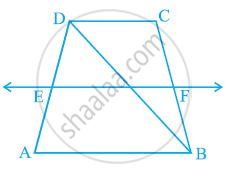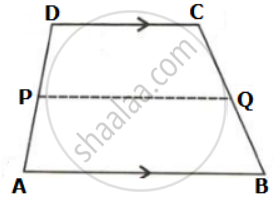Advertisements
Advertisements
प्रश्न
If L and M are the mid-points of AB, and DC respectively of parallelogram ABCD. Prove that segment DL and BM trisect diagonal AC.
उत्तर

Since L and M are the mid-points of AB and Dc respectively.
`"BL" = (1)/(2)"AB" and "Dm" = (1)/(2)"DC"`....(i)
But ABCD is a parallelogram
Therefore, AB = CD and AB || DC
⇒ BL = DM and BL || Dm ...(from (i))
⇒ BLDM is a parallelogram.
⇒ DL || Dm
⇒ LP || BQ ............(ii)
It is known that the segment drawn through the mid-point of one side of a triangle and parallel to the other side bisects the third side.
In ΔABQ , L is the mid-point of AB and MQ || PD
Therefore, P is mid-point of AQ
Hence, AP = PQ ..........(iii)
Similarly, in ΔCPD, M is the mid-point of CD and LP || BQ
Therefore, Q is mid-point of CP
Hence, PQ = QC ..........(iv)
From (iii) and (iv)
AP = PQ = QC
Therefore, P and Q trisect AC
Thus, DL and BM trisect AC.
APPEARS IN
संबंधित प्रश्न
ABCD is a trapezium in which AB || DC, BD is a diagonal and E is the mid-point of AD. A line is drawn through E parallel to AB intersecting BC at F (see the given figure). Show that F is the mid-point of BC.

Show that the line segments joining the mid-points of the opposite sides of a quadrilateral bisect each other.
In triangle ABC, P is the mid-point of side BC. A line through P and parallel to CA meets AB at point Q, and a line through Q and parallel to BC meets median AP at point R.
Prove that : (i) AP = 2AR
(ii) BC = 4QR
In triangle ABC ; D and E are mid-points of the sides AB and AC respectively. Through E, a straight line is drawn parallel to AB to meet BC at F.
Prove that BDEF is a parallelogram. If AB = 16 cm, AC = 12 cm and BC = 18 cm,
find the perimeter of the parallelogram BDEF.
In triangle ABC; M is mid-point of AB, N is mid-point of AC and D is any point in base BC. Use the intercept Theorem to show that MN bisects AD.
In the given figure, ABCD is a trapezium. P and Q are the midpoints of non-parallel side AD and BC respectively. Find: AB, if DC = 8 cm and PQ = 9.5 cm
Side AC of a ABC is produced to point E so that CE = `(1)/(2)"AC"`. D is the mid-point of BC and ED produced meets AB at F. Lines through D and C are drawn parallel to AB which meets AC at point P and EF at point R respectively. Prove that: 3DF = EF
ABCD is a parallelogram.E is the mid-point of CD and P is a point on AC such that PC = `(1)/(4)"AC"`. EP produced meets BC at F. Prove that: 2EF = BD.
In ΔABC, X is the mid-point of AB, and Y is the mid-point of AC. BY and CX are produced and meet the straight line through A parallel to BC at P and Q respectively. Prove AP = AQ.
In a parallelogram ABCD, E and F are the midpoints of the sides AB and CD respectively. The line segments AF and BF meet the line segments DE and CE at points G and H respectively Prove that: EGFH is a parallelogram.
